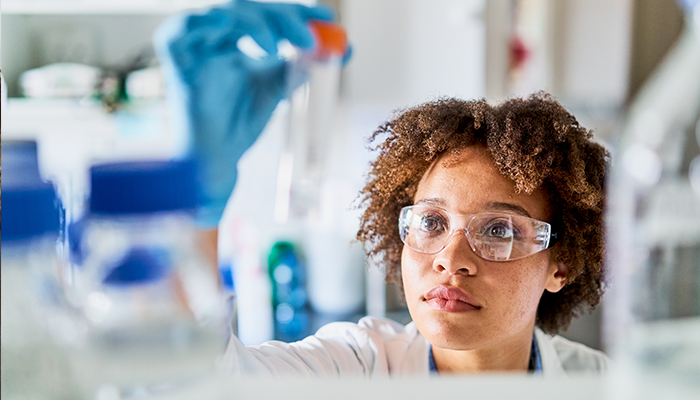HOW CAN WE HELP YOU? Call 1-800-TRY-CHOP
In This Section
FDA Approves First Gene Therapy to Treat Duchenne Muscular Dystrophy

The FDA granted accelerated approval of the first gene therapy for Duchenne muscular dystrophy.
The U.S. Food and Drug Administration's accelerated approval of the first gene therapy for Duchenne muscular dystrophy (DMD) is a major win for the field of gene therapy and for the one in 3,500 boys who are affected by the debilitating genetic disorder, according to Children's Hospital of Philadelphia experts, although questions remain about the long-term efficacy of the drug. Most patients with the condition, which causes progressive muscle degeneration, do not live past young adulthood.
The drug, known as SRP-9001 (brand name Elevidys) and made by Sarepta Therapeutics, is the 13th FDA-approved gene therapy. After facing several setbacks during the approval process, it has been greenlit for use in 4- and 5-year-old patients, with the potential for that age range to expand in the future.
The June 22 approval is based on data from a small sub-group of patients, while a larger trial continues. CHOP, which houses one of the largest DMD treatment clinics in the country, is a participating research institution in Sarepta's ongoing, multinational Phase III clinical study to test the safety and efficacy of the drug. As part of the trial, two CHOP patients have received a dose of the irreversible gene therapy.
While data from the large trial will not be available for several months, CHOP's John Brandsema, MD, said that time is of the essence for DMD patients and their families. For them, the fast-tracked approval of Elevidys offers a dose of hope.
"We're facing a tremendous foe, and for decades, scientists have been hammering away with various research attempts. Now, we have what many of us believe is the first therapy that really is making a difference," said Dr. Brandsema, an attending neurologist at CHOP with expertise in treating children with neuromuscular disorders. "It's not a cure, but we think these boys are potentially going to have many more functional years and a very different quality of life."
What is Duchenne Muscular Dystrophy, and Why is it Challenging to Treat?
Patients born with Duchenne fail to make a protein called dystrophin. This leads to a weakening of muscles over time, and patients are usually unable to walk by the time they are teenagers. The condition almost exclusively affects boys, since they only have one copy of the X chromosome, where the dystrophin gene is located.
"Dystrophin is like a shock absorber in the muscle, and so, if you don't have the dystrophin protein, then everyday activity is going to cause damage to your muscles, which will be replaced by fat and scar tissue over time," Dr. Brandsema said.
DMD seemed like a natural candidate to treat with gene therapy — scientists would theoretically use a viral vector to insert the missing DMD gene into muscle cells. However, dystrophin is the largest gene in the human genome — much too large to fit into the adeno-associated viral (AAV) vector that is typically used to deliver gene therapies to patients.
The workaround that scientists developed was to engineer a gene that would encode only the most important part of the dystrophin protein. Sarepta's Elevidys is designed to deliver a gene that codes for that truncated form of dystrophin — so-called "microdystrophin." Researchers showed that the replacement dystrophin stabilized muscle and kept it stronger in animal models, though it's not a perfect fix.
"The problem is that you have to make sacrifices when you're making microdystrophin," Dr. Brandsema said. "And so, we don't know exactly what the clinical implications are until we follow people over a period of time."
Patients enrolled in Sarepta's Phase III clinical trial, including the two participants at CHOP, received the single-dose gene therapy or a placebo. After one year, patients who initially received the therapy then received a placebo, and vice versa. Results of the Phase III clinical trial are expected to be reported by the end of 2023.
The gene therapy is irreversible and can only be administered once in a patient's lifetime, meaning that if a more efficacious version of the drug becomes available in the future, patients who participated in this Phase III trial will not be eligible to receive it. CHOP is participating in other clinical research studies that are testing different versions of microdystrophin in a similar viral vector.
"Yes, there might be ways to finesse this therapy, and people who have access to a future version of the drug may get something that works even better," Dr. Brandsema said. "But right now, this is what we have to offer people, and otherwise, they're just going to be ravaged by this terrible disease. So, regarding the approval, this was absolutely the right decision, in my opinion."
How Does the FDA's Accelerated Approval Pathway Work?
Although the FDA requires most new treatments to pass through two Phase III clinical trials to prove their efficacy, the agency's accelerated approval pathway facilitates the earlier approval of drugs that treat serious conditions. This pathway allows companies to rely on "surrogate endpoints" to prove the therapy's worth, rather than an improvement in symptoms.
In Sarepta's case, the company submitted early data of 52 boys ages 4 to 7 who received the gene therapy and used "high levels of microdystrophin" as a surrogate endpoint. The early studies showed that the boys' muscles indeed made high levels of microdystrophin; however, the patients' muscle function had no "statistically significant" improvement one year after receiving the treatment.
A more successful picture of the treatment emerged when families presented individual stories during an independent scientific advisory committee meeting in May. One reason that the early data may not have proved statistically significant improvement in muscle function, despite individual patient case reports that showed otherwise, is because the groups were stratified based on age, rather than severity of disease, according to Dr. Brandsema and other experts.
"In the field right now, there is this difficult discussion of 'Is it enough?'" said Dr. Brandsema, adding that he is acutely aware of the risks that come with any gene therapy, and administering the treatment safely is a responsibility that he and the entire gene therapy team at CHOP take seriously.
One safety concern surrounding Elevidys is that certain mutations in the dystrophin gene cause the immune system to attack microdystrophin, which can lead to dangerous inflammation in the heart and other muscles. Sarepta and other drug companies have addressed the problem by genetically screening clinical trial participants and excluding those with the mutations.
"As providers, we feel a tremendous responsibility to do this right," Dr. Brandsema said. "Not only for DMD patients receiving this gene therapy, but also in the interest of future gene therapy development for other diseases."
What is on the DMD Gene Therapy Research Horizon at CHOP?
In vivo gene therapy has a long and storied history at CHOP, including serving as the site where the first FDA-approved gene therapy for a genetic disease — Luxturna — was developed.
Sarah McCague joined CHOP in 2011 to work on early developments of that gene therapy as a clinical research coordinator, and today, she serves as administrative manager for CHOP's Clinical In Vivo Gene Therapy team. The group works across clinical departments throughout CHOP to help researchers navigate the complex considerations of clinical gene therapy research.
She has worked closely with DMD families and said that the FDA approval of Elevidys is a game-changer, not only in the gene therapy field, but for the patients and families the disease affects.
"For parents of Duchenne children, the potential of there being a treatment of any kind that has the chance of improving their child's mobility and extending their life, that is incredibly powerful for them," McCague said.
CHOP is currently participating in 35 active clinical trials to test new treatments for neuromuscular diseases, including 15 for DMD. CHOP also is offering an exon skipping treatment, which corrects for missing exons in the DMD gene, allowing the body to make a more functional form of the DMD protein; about 30% of patients with DMD are eligible for this specialized treatment.
